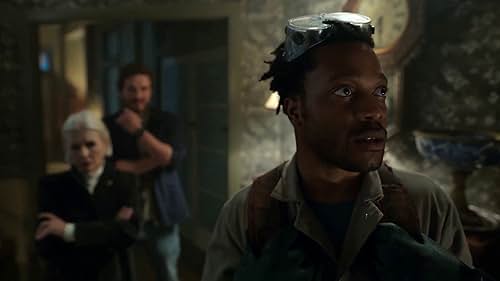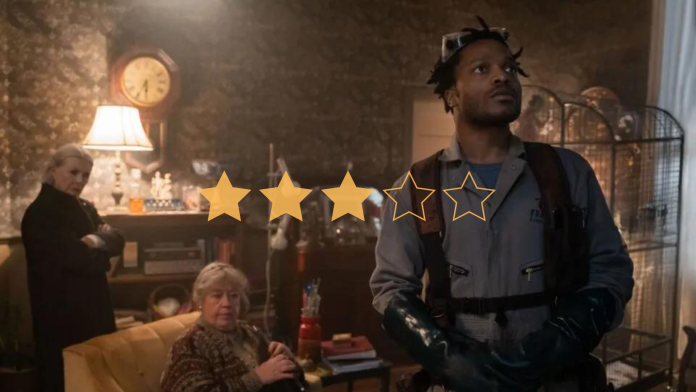When 12-year-old Charlotte (Alyla Browne) finds a spider in her apartment and keeps it in jar, it serves as a seemingly harmless distraction from her familial problems. However, as the spider begins growing at an alarming rate and residents of the apartment start disappearing, Charlotte’s pet may not have been so harmless after all.
★★★☆☆
As soon as you see a poster for a horror film with a picture of a spider and the word ‘Sting’ written across it, you may think ‘hang on, spiders don’t sting…do they?’. You are right; the reason behind the title is a little more interesting. Sting is the name Charlotte gives to her spider, taken from the name of Bilbo Baggin’s sword in The Hobbit book; ironically used to defeat giant spider Shelob in The Lord of the Rings books. This juxtaposition somewhat reflects the experience of watching director Kiah Roache-Turner’s new horror film; if you don’t take it too seriously and enjoy the monster spider being a monster spider, you may have a good time.
Charlotte’s home life acts as a backdrop to the appearance of the spider and contextualises her motivation for keeping it as a pet. She is adapting to life in her rundown apartment with her mother Heather (Penelope Mitchell), new step-dad Ethan (Ryan Corr), and her infant brother. Also living in the apartment is Charlotte’s grandmother Helga (Noni Hazlehurst) who suffers from dementia living with her resentful sister Gunter (Robyn Nevin), who are frequently calling handyman Frank (Jermaine Fowler) for apartment repairs. With all this going on, Charlotte would understandably be more than a little angsty, so who wouldn’t take on a creepy-looking spider as a pet as a source of alleviation for said angst?
All this character building serves to contextualise the horror, but not much else. Whilst the performances are adequate (Browne especially having recently displayed her non-verbal acting chops as young Furiosa in Furiosa: A Mad Max saga), the characters and story don’t particularly break any ground. All the characters are flawed in some way which creates conflict between them; Charlotte struggling to adapt to step-father Ethan’s parenting style, and Ethan himself dealing with Gunter’s dismissive attitude. Nonetheless, you know the conflict will inevitably be resolved when the characters must come together to face the horror in the final act. At this point, this trope has been done countless times in horror, which makes the story and characters relatively predictable and surface-level. This effectively makes you feel like you’re waiting to see more of the titular spider, which may be the film’s saving grace.

When the horror of Sting stings, it stings. A shot near the beginning of the film shows how the spider appears in Charlotte’s bedroom (definitely not how you’d expect), with the opening credits presented over a panning shot of the spider crawling through a doll house in a not-so-obvious bit of foreshadowing. The tension grows just as the spider grows. As Charlotte continuously feeds the spider the apartment’s resident cockroaches, it grows at an alarming rate and begins behaving more aggressively and erratically. There are a couple of moments which certainly unnerve even those who are the least arachnophobic. Not necessarily jump scares, which the film thankfully uses few, but moments where the audience can see the spider and the characters cannot. Paranoia about spiders in the house is something we can all relate to, and this is something which Sting plays on effectively. The film is effective in not giving away too much too early. In fact, the spider hides for the majority of the first half in the top of the jar, and when it does begin to attack people, you don’t see the spider itself. The audience’s imagination does the work to heighten the tension, reflected in classic monster movies like Jaws (1975) or John Carpenter’s The Thing (1982). Similarly to those films, when the spider begins to pounce on people in Sting, it is indeed as bloody and disturbing as you’d expect.

Generally, though, it wouldn’t feel fair to compare Sting to those classics. It is more reminiscent of 80s and 90s B-horror movies that you can enjoy with some friends over a few drinks, like Critters (1986), Troll (1986), and even Gremlins (1984), which I would still consider more enjoyable due to its tonal charm and effective balance of humour and horror. In comparison to other spider-based horror films, Sting wishes to be taken more seriously than films like Arachnophobia (1990) and Eight Legged Freaks (2002) but doesn’t elevate its enjoyment any more than those films due to its serious tone and heavy focus on the characters. Perhaps if Sting focused more on the horror aspect, crammed fewer characters in, or had them better written, it may have been more memorable.
The Verdict
Sting effectively plays on everyone’s innate fear of spiders, and provides a revamp of a relatively untouched and underrated sub-genre of horror. It also however suffers a fate which befalls many recent horror films—its focus on character and story can slow the pace down to a crawl (or a scuttle), resulting in a horror which is enjoyable whenever the spider is on screen, but is otherwise let down by predictability and clichés.
Words by Gareth Griffiths
Support The Indiependent
We’re trying to raise £200 a month to help cover our operational costs. This includes our ‘Writer of the Month’ awards, where we recognise the amazing work produced by our contributor team. If you’ve enjoyed reading our site, we’d really appreciate it if you could donate to The Indiependent. Whether you can give £1 or £10, you’d be making a huge difference to our small team.
